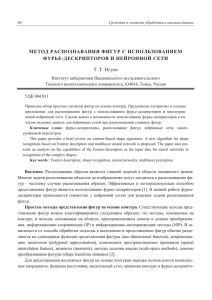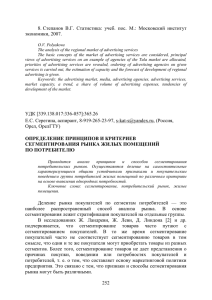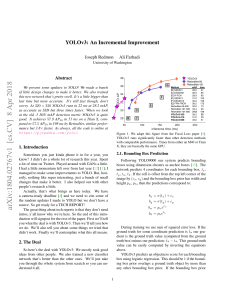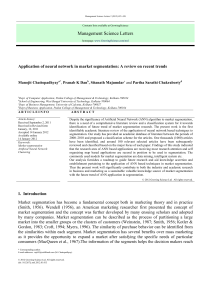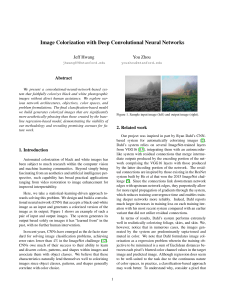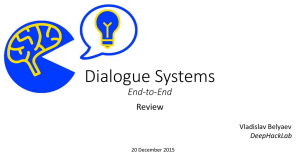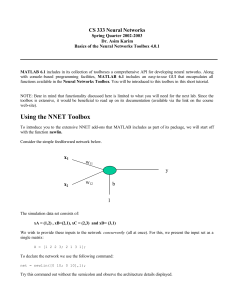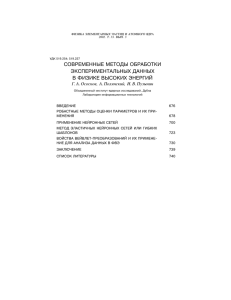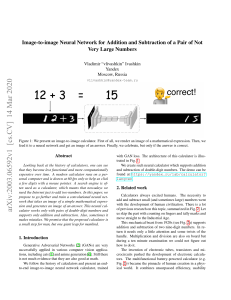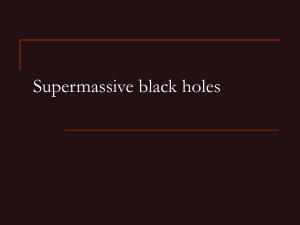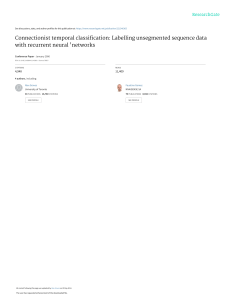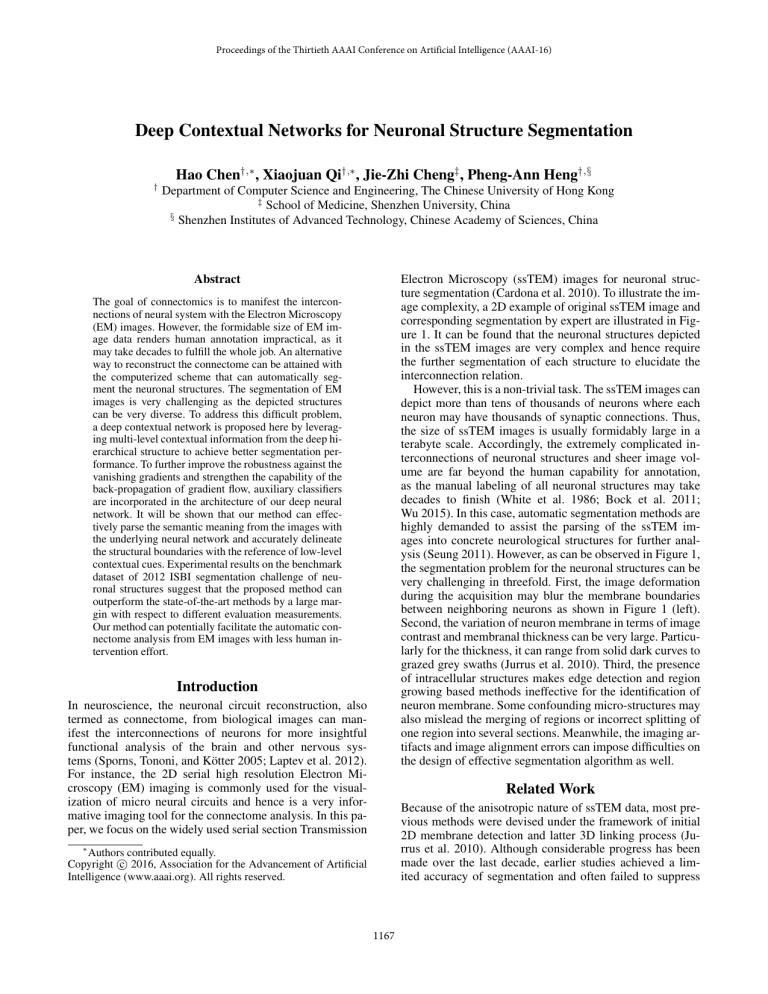
Proceedings of the Thirtieth AAAI Conference on Artificial Intelligence (AAAI-16)
Deep Contextual Networks for Neuronal Structure Segmentation
†
Hao Chen†,∗ , Xiaojuan Qi†,∗ , Jie-Zhi Cheng‡ , Pheng-Ann Heng†,§
Department of Computer Science and Engineering, The Chinese University of Hong Kong
‡
School of Medicine, Shenzhen University, China
§
Shenzhen Institutes of Advanced Technology, Chinese Academy of Sciences, China
Electron Microscopy (ssTEM) images for neuronal structure segmentation (Cardona et al. 2010). To illustrate the image complexity, a 2D example of original ssTEM image and
corresponding segmentation by expert are illustrated in Figure 1. It can be found that the neuronal structures depicted
in the ssTEM images are very complex and hence require
the further segmentation of each structure to elucidate the
interconnection relation.
However, this is a non-trivial task. The ssTEM images can
depict more than tens of thousands of neurons where each
neuron may have thousands of synaptic connections. Thus,
the size of ssTEM images is usually formidably large in a
terabyte scale. Accordingly, the extremely complicated interconnections of neuronal structures and sheer image volume are far beyond the human capability for annotation,
as the manual labeling of all neuronal structures may take
decades to finish (White et al. 1986; Bock et al. 2011;
Wu 2015). In this case, automatic segmentation methods are
highly demanded to assist the parsing of the ssTEM images into concrete neurological structures for further analysis (Seung 2011). However, as can be observed in Figure 1,
the segmentation problem for the neuronal structures can be
very challenging in threefold. First, the image deformation
during the acquisition may blur the membrane boundaries
between neighboring neurons as shown in Figure 1 (left).
Second, the variation of neuron membrane in terms of image
contrast and membranal thickness can be very large. Particularly for the thickness, it can range from solid dark curves to
grazed grey swaths (Jurrus et al. 2010). Third, the presence
of intracellular structures makes edge detection and region
growing based methods ineffective for the identification of
neuron membrane. Some confounding micro-structures may
also mislead the merging of regions or incorrect splitting of
one region into several sections. Meanwhile, the imaging artifacts and image alignment errors can impose difficulties on
the design of effective segmentation algorithm as well.
Abstract
The goal of connectomics is to manifest the interconnections of neural system with the Electron Microscopy
(EM) images. However, the formidable size of EM image data renders human annotation impractical, as it
may take decades to fulfill the whole job. An alternative
way to reconstruct the connectome can be attained with
the computerized scheme that can automatically segment the neuronal structures. The segmentation of EM
images is very challenging as the depicted structures
can be very diverse. To address this difficult problem,
a deep contextual network is proposed here by leveraging multi-level contextual information from the deep hierarchical structure to achieve better segmentation performance. To further improve the robustness against the
vanishing gradients and strengthen the capability of the
back-propagation of gradient flow, auxiliary classifiers
are incorporated in the architecture of our deep neural
network. It will be shown that our method can effectively parse the semantic meaning from the images with
the underlying neural network and accurately delineate
the structural boundaries with the reference of low-level
contextual cues. Experimental results on the benchmark
dataset of 2012 ISBI segmentation challenge of neuronal structures suggest that the proposed method can
outperform the state-of-the-art methods by a large margin with respect to different evaluation measurements.
Our method can potentially facilitate the automatic connectome analysis from EM images with less human intervention effort.
Introduction
In neuroscience, the neuronal circuit reconstruction, also
termed as connectome, from biological images can manifest the interconnections of neurons for more insightful
functional analysis of the brain and other nervous systems (Sporns, Tononi, and Kötter 2005; Laptev et al. 2012).
For instance, the 2D serial high resolution Electron Microscopy (EM) imaging is commonly used for the visualization of micro neural circuits and hence is a very informative imaging tool for the connectome analysis. In this paper, we focus on the widely used serial section Transmission
Related Work
Because of the anisotropic nature of ssTEM data, most previous methods were devised under the framework of initial
2D membrane detection and latter 3D linking process (Jurrus et al. 2010). Although considerable progress has been
made over the last decade, earlier studies achieved a limited accuracy of segmentation and often failed to suppress
∗
Authors contributed equally.
c 2016, Association for the Advancement of Artificial
Copyright Intelligence (www.aaai.org). All rights reserved.
1167
pose a novel deep contextual segmentation network to demarcate the neuronal structure in EM stacks. This approach
incorporates the multi-level contextual information with different receptive fields, thus it can remove the ambiguities of
membranal boundaries in essence that previous studies may
fail. Inspired by previous studies (Ciresan et al. 2012; Lee
et al. 2014), we further make the model deeper than (Ciresan et al. 2012) and add auxiliary supervised classifiers to
encourage the back-propagation flow. This augmented network can further unleash the power of deep neural networks
for neuronal structure segmentation. Quantitative evaluation
was extensively conducted on the public dataset of 2012
ISBI EM Segmentation Challenge (Ignacio et al. 2012), with
rich baseline results for comparison in terms of pixel- and
object-level evaluation. Our method achieved the state-ofthe-art results, which outperformed those of other methods
on all evaluation measurements. It is also worth noting that
our results surpassed the annotation by neuroanatomists on
the measurement of warping error.
Figure 1: Left: the original ssTEM image. Right: the corresponding segmentation annotation (individual components
are denoted by different colors).
the intracellular structures effectively with the hand-crafted
features, e.g., radon and ray-like features (Kumar, VázquezReina, and Pfister 2010; Mishchenko 2009; Laptev et al.
2012; Kaynig, Fuchs, and Buhmann 2010). Recently, deep
neural networks with hierarchical feature representations
have achieved promising results in various applications,
including image classification (Krizhevsky, Sutskever, and
Hinton 2012), object detection (Simonyan and Zisserman
2014; Chen et al. 2015) and segmentation (Long, Shelhamer,
and Darrell 2014). In terms of EM segmentation, Ciresan
et al. (2012) employed the deep convolutional neural network as a pixel-wise classifier by taking a square window
centered on the pixel itself as input, which contains contextual appearance information. This method achieved the best
performance in 2012 ISBI neuronal structure segmentation
challenge. A variant version with iterative refining process
has been proposed to withstand the noise and recover the
boundaries (Wu 2015). Besides, several methods worked on
the probability maps produced by deep convolutional neural
networks as a post-processing step, such as learning based
adaptive watershed (Uzunbaş, Chen, and Metaxsas 2014),
hierarchical merge tree with consistent constraints (Liu et al.
2014) and active learning approach for hierarchical agglomerative segmentation (Nunez-Iglesias et al. 2013), to further
improve the performance. These methods refined the segmentation results with respect to the measurements of rand
error and warping error (Jain et al. 2010) with significant
performance boost in comparison to the results of (Ciresan
et al. 2012).
However, the performance gap between the computerized
results and human neuroanatomist annotations can be still
perceivable. There are two main drawbacks of previous deep
learning based studies on this task. First, the operation of
sliding window scanning imposes a heavy burden on the
computational efficiency. This must be taken into consideration seriously regarding the large scale neuronal structure reconstruction. Second, the size of neuronal structure
can be very diverse in EM images. Although, classification
with single size sub-window can achieve good performance,
it may produce unsatisfactory results in some regions where
the size of contextual window is set inappropriately.
In order to tackle the aforementioned challenges, we pro-
Method
Deeply Supervised Contextual Network
In this section, we present a deeply supervised contextual
network for neuronal structure segmentation. Inspired by recent studies of fully convolutional networks (FCN) (Long,
Shelhamer, and Darrell 2014; Chen et al. 2014), which replace the fully connected layers with all convolutional kernels, the proposed network is a variant and takes full advantage of convolutional kernels for efficient and effective image segmentation. The architecture of the proposed method
is illustrated in Figure 2. It basically contains two modules, i.e., down-sampling path with convolutional and maxpooling layers and upsampling path with convolutional and
deconvolutional layers. Noting that we upsampled the feature maps with the backwards strided convolution in the upsampling path, thus we call them as deconvolutional layers.
The downsampling path aims at classifying the semantical
meanings based on the high level abstract information, while
the upsampling path reconstructing the fine details such as
boundaries. The upsampling layers are designed by taking
full advantage of the different feature maps in hierarchical
layers.
The basic idea behind this is that global or abstract information from higher layers helps to resolve the problem
of what (i.e., classification capability) and local information
from lower layers helps to resolve the problem of where
(i.e., localization accuracy). Finally, these multi-level contextual information are fused together with a summing operation. The probability maps are generated by inputting
the fused map into a softmax classification layer. Specifically, the architecture of neural network contains 16 convolutional layers, 3 max-pooling layers for downsampling
and 3 deconvolutional layers for upsampling. The convolutional layers along with convolutional kernels (3 × 3 or
1 × 1) perform linear mapping with shared parameters. The
max-pooling layers downsample the size of feature maps by
the max-pooling operation (kernel size 2 × 2 with a stride
2). The deconvolutional layers upsample the size of feature
1168
PD[SRRO[
XSFRQY
FRQY[
FRQY[
FODVVLILHU
IXVLRQ
[
ሺݔǢ ܹሻ
&
&
[
&
[
,QSXW
6RIWPD[
Figure 2: The architecture of the proposed deep contextual network.
maps by the backwards strided convolution (Long, Shelhamer, and Darrell 2014) (2k × 2k kernel with a stride k,
k = 2, 4 and 8 for upsampling layers, respectively). A nonlinear mapping layer (element-wise rectified linear activations) is followed for each layer that contains parameters to
be trained (Krizhevsky, Sutskever, and Hinton 2012).
In order to alleviate the problem of vanishing gradients
and encourage the back-propagation of gradient flow in deep
neural networks, the auxiliary classifiers C are injected for
training the network. Furthermore, they can serve as regularization for reducing the overfitting and improve the discriminative capability of features in intermediate layers (Bengio
et al. 2007; Lee et al. 2014; Wang et al. 2015). The classification layer after fusing multi-level contextual information
produces the EM image segmentation results by leveraging
the hierarchical feature representations. Finally, the training of whole network is formulated as a per-pixel classification problem with respect to the ground-truth segmentation
masks, as shown following:
λ L(X ; θ) = (
||Wc ||22 + ||W ||22 )−
2 c
wc ψc (x, (x)) −
ψ(x, (x))
(1)
c
x∈X
network are jointly optimized in an end-to-end way by minimizing the total loss function L. For the testing data of EM
images, the results are produced with an overlap-tile strategy
to improve the robustness.
Importance of Receptive Field
In the task of EM image segmentation, there is a large variation on the size of neuronal structures. Therefore, the size
of receptive field plays a key role in the pixel-wise classification given the corresponding contextual information. It’s
approximated as the size of object region with surrounding
context, which is reflected as the intensity values within the
window. As shown in Figure 3, different regions may depend on a different window size. For example, the cluttered
neurons need a small window size for clearly separating the
membranes between neighboring neurons, while a large size
is required for neurons containing intracellular structures so
as to suppress the false predictions. In the hierarchical structure of deep contextual networks, these upsampling layers
have different receptive fields. With the depth increasing, the
size of receptive field is becoming larger. Therefore, it can
handle the variations of reception field size properly that different regions demand for correct segmentation while taking
advantage of the hierarchical feature representations.
x∈X
where the first part is the regularization term and latter one
including target and auxiliary classifiers is the data loss term.
The tradeoff of these two terms is controlled by the hyperparameter λ. Specifically, W denotes the parameters for inferring the target output p(x; W ), ψ(x, (x)) denotes the cross
entropy loss regarding the true label (x) for pixel x in image
space X , similarly ψc (x, (x)) is the loss from cth auxiliary
classifier with parameters Wc for inferring the output, the
parameter wc denotes the corresponding discount weight.
Finally, the parameters θ = {W, Wc } of deep contextual
Morphological Boundary Refinement
Although the probability maps output from the deep contextual network are visually very good, we observe that the
membrane of ambiguous regions can sometimes be discontinued. This is partially caused by the averaging effect of
probability maps, which are generated by several trained
models. Therefore, we utilized an off-the-shelf watershed
algorithm (Beucher and Lantuejoul 1979) to refine the contour. The final fusion result pf (x) was produced by fusing
1169
2.50 GHz Intel(R) Xeon(R) E5-1620 CPU and a NVIDIA
GeForce GTX Titan X GPU.
Qualitative Evaluation
Two examples of qualitative segmentation results without
morphological boundary refinement are demonstrated in
Figure 4. We can see that our method can generate visually
smooth and accurate segmentation results. As the red arrows
shown in the figure, it can successfully suppress the intracellular structures and produce good probability maps that classify the membrane and non-membrane correctly. Furthermore, by utilizing multi-level representations of contextual
information, our method can also close gaps (contour completion as the blue arrows shown in Figure 4) in places where
the contrast of membrane is low. Although there still exist
ambiguous regions which are even hard for human experts,
the results of our method are more accurate in comparison to
those generated from previous deep learning studies (Stollenga et al. 2015; Ciresan et al. 2012). This evidenced the
efficacy of our proposed method qualitatively.
Figure 3: Illustration of contextual window size. Left: the
original ssTEM image. Right: manual segmentation result
by an expert human neuroanatomist (black and white pixels
denote the membrane and non-membrane, respectively).
the binary contour pw (x) and original probability map p(x)
with linear combination:
pf (x) = wf p(x) + (1 − wf )pw (x)
(2)
The parameter wf is determined by obtaining the optimal
result of rand error on the training data in our experiments.
Quantitative Evaluation and Comparison
In the 2012 ISBI EM Segmentation Challenge, the performance of different competing methods is ranked based on
their pixel and object classification accuracy. Specifically,
the 2D topology-based segmentation evaluation metrics include rand error, warping error and pixel error (Ignacio et al.
2012; Jain et al. 2010), which are defined as following:
Rand error: 1 - the maximal F-score of the foregroundrestricted rand index (Rand 1971), a measure of similarity
between two clusters or segmentations. For the EM segmentation evaluation, the zero component of the original labels
(background pixels of the ground truth) is excluded.
Warping error: a segmentation metric that penalizes the
topological disagreements (object splits and mergers).
Pixel error: 1 - the maximal F-score of pixel similarity, or
squared Euclidean distance between the original and the result labels.
The evaluation system thresholds the probability maps
with 9 different values (0.1-0.9 with an interval 0.1) separately and return the minimum error for each segmentation metric. The quantitative comparison of different methods can be seen in Table 1. Noting that the results show
the best performance for each measurement across all submissions by each team individually. More details and results are available at the leader board1 . We compared our
method with the state-of-the-art methods with or without
post-processing separately. Furthermore, we conducted extensive experiments with ablation studies to probe the performance gain in our method and detail as following.
Experiments and Results
Data and Preprocessing
We evaluated our method on the public dataset of 2012 ISBI
EM Segmentation Challenge (Ignacio et al. 2012), which is
still open for submissions. The training dataset contains a
stack of 30 slices from a ssTEM dataset of the Drosophila
first instar larva ventral nerve cord (VNC), which measures
approximately 2x2x1.5 microns with a resolution of 4x4x50
nm/voxel. The images were manually annotated in the pixellevel by a human neuroanatomist using the software tool
TrakEm2 (Cardona et al. 2012). The ground truth masks of
training data were provided while those of testing data with
30 slices were held out by the organizers for evaluation. We
evaluated the performance of our method by submitting results to the online testing system. In order to improve the robustness of neural network, we utilized the strategy of data
augmentation to enlarge the training dataset (about 10 times
larger). The transformations of data augmentation include
scaling, rotation, flipping, mirroring and elastic distortion.
Details of Training
The proposed method was implemented with the mixed programming technology of Matlab and C++ under the opensource framework of Caffe library (Jia et al. 2014). We randomly cropped a region (size 480 × 480) from the original image as the input into the network and trained it with
standard back-propagation using stochastic gradient descent
(momentum = 0.9, weight decay = 0.0005, the learning rate
was set as 0.01 initially and decreased by a factor of 10 every two thousand iterations). The parameter of corresponding discount weight wc was set as 1 initially and decreased
by a factor of 10 every ten thousand iterations till a negligible value 0.01. The training time on the augmentation
dataset took about three hours using a standard PC with a
Results Comparison without Post-Processing Preliminary encouraging results were achieved by IDSIA
team (Ciresan et al. 2012), which utilized a deep convolutional neural network as a pixel-wise classifier in a sliding
window way. The best results were obtained by averaging
1
Please refer to the leader board for more details: http://
brainiac2.mit.edu/isbi challenge/leaders-board
1170
6OLFH
6OLFH
Figure 4: Examples of original EM images and segmentation results by our method (the darker color of pixels denotes the
higher probability of being membrane in neuronal structure).
Table 1: Results of 2012 ISBI Segmentation Challenge on Neuronal Structures
Group name
Rand Error
Warping Error
Pixel Error
Rank
0.002109173
0.017334163
0.017841947
0.018919792
0.022777620
0.026326384
0.028054308
0.038225781
0.045905709
0.046704591
0.047680695
0.048314096
0.060110507
0.063919883
0.000005341
0.000000000
0.000307083
0.000616837
0.000807953
0.000426483
0.000515747
0.000352859
0.000478999
0.000462341
0.000374222
0.000434367
0.000495529
0.000581741
0.001041591
0.057953485
0.058436986
0.102692786
0.110460288
0.062739851
0.063349324
0.061141279
0.062029263
0.061624006
0.058205303
0.060298549
0.068537199
0.079403258
1
2
3
4
5
6
7
8
9
10
11
12
13
0.043419035
0.000342178
0.046058434
0.000421524
0.258966855
0.001080322
0.035134666
0.000334167
0.040492503
0.000330353
0.040406591
0.000000000
0.017334163
0.000188446
There are total 38 teams participating this challenge till Sep 2015.
0.060940140
0.061248112
0.102325669
0.058372960
0.062864362
0.059902422
0.057953485
** human values **
CUMedVision (Our)
DIVE-SCI
IDSIA-SCI
optree-idsia (Uzunbaş, Chen, and Metaxsas 2014)
motif (Wu 2015)
SCI (Liu et al. 2014)
Image Analysis Lab Freiburg (Ronneberger, Fischer, and Brox 2015)
Connectome
PyraMiD-LSTM (Stollenga et al. 2015)
DIVE
IDSIA (Ciresan et al. 2012)
INI
MLL-ETH (Laptev et al. 2012)
CUMedVision-4(C3)
CUMedVision-4(C2)
CUMedVision-4(C1)
CUMedVision-4(with C)
CUMedVision-4(w/o C)
CUMedVision-6(with C)
CUMedVision-4(with fusion)
the outputs from 4 deep neural network models. Different
from this method by training the neural network with different window sizes (65 and 95) separately, our approach
integrates multi-size windows (i.e., different receptive fields
in upsampling layers) into one unified framework. This can
help to generate more accurate probability maps by leveraging multi-level contextual information. The Image Analysis
Lab Freiburg team (Ronneberger, Fischer, and Brox 2015)
designed a deep U-shaped network by concatenating features from lower layers and improved the results than those
of (Ciresan et al. 2012). This further demonstrated the effectiveness of contextual information for accurate segmentation. However, with such a deep network (i.e., 23 convolutional layers), the back-propagation of gradient flow may
be a potential issue and training took a long time (about 10
hours). Instead of using the convolutional neural network,
the PyraMiD-LSTM team employed a novel parallel multidimensional long short-term memory model for fast volumetric segmentation (Stollenga et al. 2015). Unfortunately, a
relatively inferior performance was achieved by this method.
From Table 1, we can see that our deep segmentation network (with 6 model averaging results, i.e., CUMedVision6(with C)) without watershed fusion achieved the best performance in terms of warping error, which outperformed
other methods by a large margin. Notably it’s the only result that surpasses the performance of expert neuroanatomist
annotation. Our submitted entry CUMedVision-4(with C) on
averaging 4 models (the same number of models as (Ciresan
et al. 2012)) achieved much smaller rand and warping errors
than the results of other teams also employing deep learning
methods without sophisticated post-processing steps, such
as DIVE, IDSIA, and Image Analysis Lab Freiburg. This cor-
1171
roborates the superiority of our approach by exploring multilevel contextual information with auxiliary supervision.
configuration of training. Taking advantage of fully convolutional networks, the computation time is much less than
previous studies (Ciresan et al. 2012; Wu 2015) utilizing a
sliding window way, which caused a large number of redundant computations on neighboring pixels. With new imaging
techniques producing much larger volumes (terabyte scale)
that contain thousands of neurons and millions of synapses,
the automatic methods with accurate and fast segmentation
capabilities are of paramount importance. The fast speed and
better accuracy of our method make it possible for large
scale image analysis.
Results Comparison with Post-Processing In order to
further reduce the errors, we fused the results from watershed method as illustrated in the method section, which
can reduce the rand error dramatically while increasing
the warping error unfortunately. This is reasonable since
these two errors consider the segmentation evaluation metric from different aspects. The former one could penalize
even slightly misplaced boundaries while the latter one disregards non-topological errors. Different from our simple
post-processing step, the SCI team post-processed the probability maps generated by the team DIVE and IDSIA with
a sophisticated post-processing strategy (Liu et al. 2014).
The post-processed results were evaluated under the team
name of DIVE-SCI and IDSIA-SCI, respectively. Although
it utilized a supervised way with hierarchical merge tree
to achieve structure consistency, the performance is relatively inferior compared to ours, in which only an unsupervised watershed method was used for post-processing. In
addition, our method also outperformed other methods with
sophisticated post-processing techniques including optreeidsia and motif by a large margin. This further highlights
the advantages of our method by exploring multi-level contextual information to generate probability maps with better
likelihood. We released the probability maps including training and testing data of our method for enlightening further
sophisticated post-processing strategies2 .
Conclusion
In this paper we have presented a deeply supervised contextual neural network for neuronal structure segmentation.
By harnessing the multi-level contextual information from
the deep hierarchical feature representations, it can have
better discrimination and localization abilities, which are
key to image segmentation related tasks. The injected auxiliary classifiers can help to encourage the back-propagation
of gradient flow in training the deep neural network, thus
further improve the segmentation performance. Extensive
experiments on the public dataset of 2012 ISBI EM Segmentation Challenge corroborated the effectiveness of our
method. We believe the promising results are a significant
step towards automated reconstruction of the connectome.
In addition, our approach is general and can be easily extended to other biomedical applications. Future work will include further refining the segmentation results with other sophisticated post-processing techniques (Uzunbaş, Chen, and
Metaxsas 2014; Liu et al. 2014; Nunez-Iglesias et al. 2013)
and investigating on more biomedical applications.
Ablation Studies of Our Method In order to probe
the performance gain of our proposed method, extensive
ablation studies were conducted to investigate the role
of each component. As illustrated in Table 1, compared
with methods using single contextual information including CUMedVision-4(C3/C2/C1), the deep contextual model
harnessing the multi-level contextual cues achieved significantly better performance on all the measurements. Furthermore, we compared the performance with (CUMedVision4(with C)) and without (CUMedVision-4(w/o C)) the injection of auxiliary classifiers C, the rand error and pixel error
from method with C were much smaller while the warping
error with C is competitive compared to the method without
C. This validated the efficacy of auxiliary classifiers with
deep supervision for encouraging back-propagation of gradient flow. By fusing the results from the watershed method,
we achieved the result with rand error 0.017334, warping
error 0.000188, and pixel error 0.057953, which outperforms those from other teams by a large margin. To sum
up, our method achieved the best performance on different
evaluation measurements, which demonstrates the promising possibility for read-world applications. Although there
is a tradeoff with respect to different evaluation metrics, the
neuroanatomists can choose the desirable results based on
the specific neurological requirements.
Acknowledgements This work is supported by National
Basic Research Program of China, 973 Program (No.
2015CB351706) and a grant from Ministry of Science
and Technology of the People’s Republic of China under the Singapore-China 9th Joint Research Program (No.
2013DFG12900). The authors also gratefully thank the challenge organizers for helping the evaluation.
References
Bengio, Y.; Lamblin, P.; Popovici, D.; Larochelle, H.; et al.
2007. Greedy layer-wise training of deep networks. Advances in neural information processing systems 19:153.
Beucher, S., and Lantuejoul, C. 1979. Use of watersheds
in contour detection. In International Conference on Image
Processing.
Bock, D. D.; Lee, W.-C. A.; Kerlin, A. M.; Andermann,
M. L.; Hood, G.; Wetzel, A. W.; Yurgenson, S.; Soucy, E. R.;
Kim, H. S.; and Reid, R. C. 2011. Network anatomy
and in vivo physiology of visual cortical neurons. Nature
471(7337):177–182.
Cardona, A.; Saalfeld, S.; Preibisch, S.; Schmid, B.; Cheng,
A.; Pulokas, J.; Tomancak, P.; and Hartenstein, V. 2010.
An integrated micro-and macroarchitectural analysis of the
drosophila brain by computer-assisted serial section electron
microscopy. PLoS biology 8(10):2564.
Computation Time Generally, it took about 0.4 seconds
to process one test image with size 512×512 using the same
2
Results: http://appsrv.cse.cuhk.edu.hk\%7Ehchen/research/
2012isbi seg.html
1172
Cardona, A.; Saalfeld, S.; Schindelin, J.; Arganda-Carreras,
I.; Preibisch, S.; Longair, M.; Tomancak, P.; Hartenstein, V.;
and Douglas, R. J. 2012. Trakem2 software for neural circuit
reconstruction. PloS one 7(6):e38011.
Chen, L.-C.; Papandreou, G.; Kokkinos, I.; Murphy, K.; and
Yuille, A. L. 2014. Semantic image segmentation with deep
convolutional nets and fully connected crfs. arXiv preprint
arXiv:1412.7062.
Chen, H.; Shen, C.; Qin, J.; Ni, D.; Shi, L.; Cheng, J. C.; and
Heng, P.-A. 2015. Automatic localization and identification of vertebrae in spine ct via a joint learning model with
deep neural networks. In Medical Image Computing and
Computer-Assisted Intervention–MICCAI 2015. Springer.
515–522.
Ciresan, D.; Giusti, A.; Gambardella, L. M.; and Schmidhuber, J. 2012. Deep neural networks segment neuronal
membranes in electron microscopy images. In Advances in
neural information processing systems, 2843–2851.
Ignacio, A.-C.; Sebastian, S.; Albert, C.; and Johannes, S.
2012. 2012 ISBI Challenge: Segmentation of neuronal structures in EM stacks. http://brainiac2.mit.edu/isbi challenge/.
Jain, V.; Bollmann, B.; Richardson, M.; Berger, D. R.;
Helmstaedter, M. N.; Briggman, K. L.; Denk, W.; Bowden, J. B.; Mendenhall, J. M.; Abraham, W. C.; et al.
2010. Boundary learning by optimization with topological
constraints. In Computer Vision and Pattern Recognition
(CVPR), 2010 IEEE Conference on, 2488–2495. IEEE.
Jia, Y.; Shelhamer, E.; Donahue, J.; Karayev, S.; Long, J.;
Girshick, R.; Guadarrama, S.; and Darrell, T. 2014. Caffe:
Convolutional architecture for fast feature embedding. arXiv
preprint arXiv:1408.5093.
Jurrus, E.; Paiva, A. R.; Watanabe, S.; Anderson, J. R.;
Jones, B. W.; Whitaker, R. T.; Jorgensen, E. M.; Marc, R. E.;
and Tasdizen, T. 2010. Detection of neuron membranes in
electron microscopy images using a serial neural network
architecture. Medical image analysis 14(6):770–783.
Kaynig, V.; Fuchs, T. J.; and Buhmann, J. M. 2010. Geometrical consistent 3d tracing of neuronal processes in sstem
data. In Medical Image Computing and Computer-Assisted
Intervention–MICCAI 2010. Springer. 209–216.
Krizhevsky, A.; Sutskever, I.; and Hinton, G. E. 2012.
Imagenet classification with deep convolutional neural networks. In Advances in neural information processing systems, 1097–1105.
Kumar, R.; Vázquez-Reina, A.; and Pfister, H. 2010. Radonlike features and their application to connectomics. In Computer Vision and Pattern Recognition Workshops (CVPRW),
2010 IEEE Computer Society Conference on, 186–193.
IEEE.
Laptev, D.; Vezhnevets, A.; Dwivedi, S.; and Buhmann,
J. M. 2012. Anisotropic sstem image segmentation using
dense correspondence across sections. In Medical Image
Computing and Computer-Assisted Intervention–MICCAI
2012. Springer. 323–330.
Lee, C.-Y.; Xie, S.; Gallagher, P.; Zhang, Z.; and Tu,
Z.
2014.
Deeply-supervised nets.
arXiv preprint
arXiv:1409.5185.
Liu, T.; Jones, C.; Seyedhosseini, M.; and Tasdizen, T. 2014.
A modular hierarchical approach to 3d electron microscopy
image segmentation. Journal of neuroscience methods
226:88–102.
Long, J.; Shelhamer, E.; and Darrell, T. 2014. Fully convolutional networks for semantic segmentation. arXiv preprint
arXiv:1411.4038.
Mishchenko, Y. 2009. Automation of 3d reconstruction of
neural tissue from large volume of conventional serial section transmission electron micrographs. Journal of neuroscience methods 176(2):276–289.
Nunez-Iglesias, J.; Kennedy, R.; Parag, T.; Shi, J.;
Chklovskii, D. B.; and Zuo, X.-N. 2013. Machine learning of hierarchical clustering to segment 2d and 3d images.
PloS one 8(8):08.
Rand, W. M. 1971. Objective criteria for the evaluation
of clustering methods. Journal of the American Statistical
association 66(336):846–850.
Ronneberger, O.; Fischer, P.; and Brox, T. 2015. U-net:
Convolutional networks for biomedical image segmentation.
arXiv preprint arXiv:1505.04597.
Seung, H. S. 2011. Neuroscience: towards functional connectomics. Nature 471(7337):170–172.
Simonyan, K., and Zisserman, A. 2014. Very deep convolutional networks for large-scale image recognition. arXiv
preprint arXiv:1409.1556.
Sporns, O.; Tononi, G.; and Kötter, R. 2005. The human
connectome: a structural description of the human brain.
PLoS Comput Biol 1(4):e42.
Stollenga, M. F.; Byeon, W.; Liwicki, M.; and Schmidhuber,
J. 2015. Parallel multi-dimensional lstm, with application
to fast biomedical volumetric image segmentation. arXiv
preprint arXiv:1506.07452.
Uzunbaş, M. G.; Chen, C.; and Metaxsas, D. 2014. Optree:
a learning-based adaptive watershed algorithm for neuron
segmentation. In Medical Image Computing and ComputerAssisted Intervention–MICCAI 2014. Springer. 97–105.
Wang, L.; Lee, C.-Y.; Tu, Z.; and Lazebnik, S. 2015. Training deeper convolutional networks with deep supervision.
arXiv preprint arXiv:1505.02496.
White, J.; Southgate, E.; Thomson, J.; and Brenner, S.
1986. The structure of the nervous system of the nematode
caenorhabditis elegans: the mind of a worm. Phil. Trans. R.
Soc. Lond 314:1–340.
Wu, X. 2015. An iterative convolutional neural network algorithm improves electron microscopy image segmentation.
arXiv preprint arXiv:1506.05849.
1173
